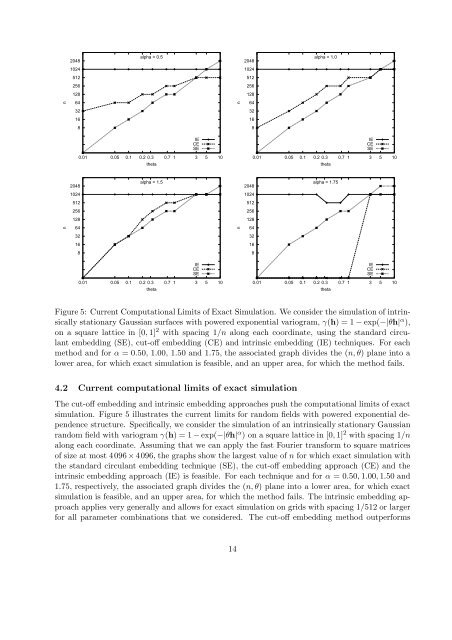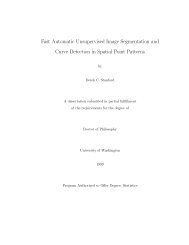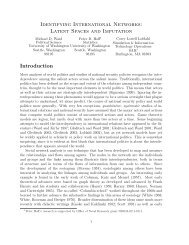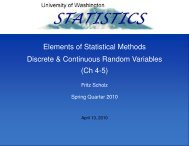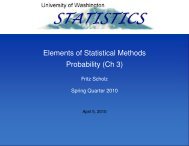Fast and Exact Simulation of Large Gaussian Lattice Systems in ...
Fast and Exact Simulation of Large Gaussian Lattice Systems in ...
Fast and Exact Simulation of Large Gaussian Lattice Systems in ...
Create successful ePaper yourself
Turn your PDF publications into a flip-book with our unique Google optimized e-Paper software.
2048alpha = 0.52048alpha = 1.010241024512512256256128128n64n6432321616880.01 0.05 0.1 0.2 0.3 0.7 1 3 5 10thetaIECESE0.01 0.05 0.1 0.2 0.3 0.7 1 3 5 10thetaIECESE2048alpha = 1.52048alpha = 1.7510241024512512256256128128n64n6432321616880.01 0.05 0.1 0.2 0.3 0.7 1 3 5 10thetaIECESE0.01 0.05 0.1 0.2 0.3 0.7 1 3 5 10thetaIECESEFigure 5: Current Computational Limits <strong>of</strong> <strong>Exact</strong> <strong>Simulation</strong>. We consider the simulation <strong>of</strong> <strong>in</strong>tr<strong>in</strong>sicallystationary <strong>Gaussian</strong> surfaces with powered exponential variogram, γ(h) = 1 − exp(−|θh| α ),on a square lattice <strong>in</strong> [0, 1] 2 with spac<strong>in</strong>g 1/n along each coord<strong>in</strong>ate, us<strong>in</strong>g the st<strong>and</strong>ard circulantembedd<strong>in</strong>g (SE), cut-<strong>of</strong>f embedd<strong>in</strong>g (CE) <strong>and</strong> <strong>in</strong>tr<strong>in</strong>sic embedd<strong>in</strong>g (IE) techniques. For eachmethod <strong>and</strong> for α = 0.50, 1.00, 1.50 <strong>and</strong> 1.75, the associated graph divides the (n, θ) plane <strong>in</strong>to alower area, for which exact simulation is feasible, <strong>and</strong> an upper area, for which the method fails.4.2 Current computational limits <strong>of</strong> exact simulationThe cut-<strong>of</strong>f embedd<strong>in</strong>g <strong>and</strong> <strong>in</strong>tr<strong>in</strong>sic embedd<strong>in</strong>g approaches push the computational limits <strong>of</strong> exactsimulation. Figure 5 illustrates the current limits for r<strong>and</strong>om fields with powered exponential dependencestructure. Specifically, we consider the simulation <strong>of</strong> an <strong>in</strong>tr<strong>in</strong>sically stationary <strong>Gaussian</strong>r<strong>and</strong>om field with variogram γ(h) = 1 − exp(−|θh| α ) on a square lattice <strong>in</strong> [0, 1] 2 with spac<strong>in</strong>g 1/nalong each coord<strong>in</strong>ate. Assum<strong>in</strong>g that we can apply the fast Fourier transform to square matrices<strong>of</strong> size at most 4096 × 4096, the graphs show the largest value <strong>of</strong> n for which exact simulation withthe st<strong>and</strong>ard circulant embedd<strong>in</strong>g technique (SE), the cut-<strong>of</strong>f embedd<strong>in</strong>g approach (CE) <strong>and</strong> the<strong>in</strong>tr<strong>in</strong>sic embedd<strong>in</strong>g approach (IE) is feasible. For each technique <strong>and</strong> for α = 0.50, 1.00, 1.50 <strong>and</strong>1.75, respectively, the associated graph divides the (n, θ) plane <strong>in</strong>to a lower area, for which exactsimulation is feasible, <strong>and</strong> an upper area, for which the method fails. The <strong>in</strong>tr<strong>in</strong>sic embedd<strong>in</strong>g approachapplies very generally <strong>and</strong> allows for exact simulation on grids with spac<strong>in</strong>g 1/512 or largerfor all parameter comb<strong>in</strong>ations that we considered. The cut-<strong>of</strong>f embedd<strong>in</strong>g method outperforms14


